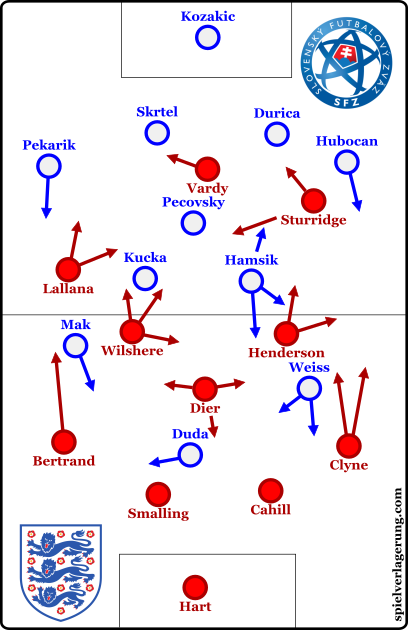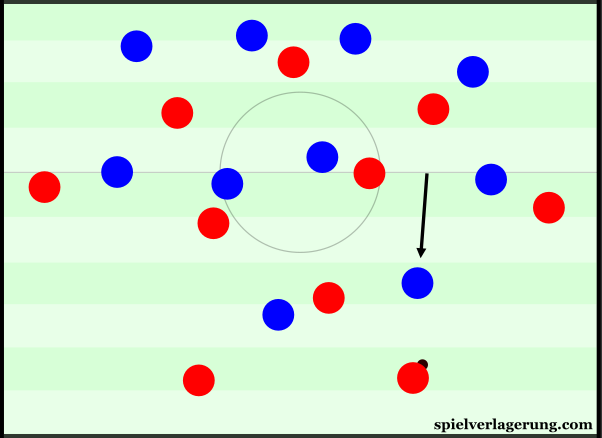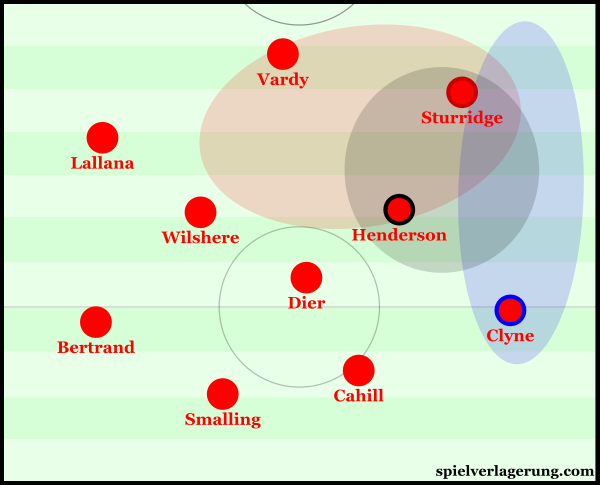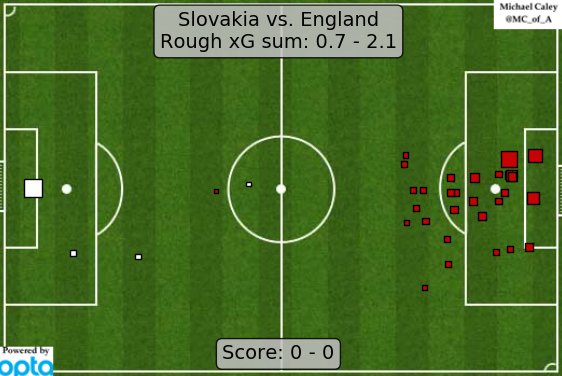England perform well despite stalemate against Slovakia
Whilst England made an impressive performance in their final group-match, they were unable to mark against a deeply-set Slovakia defence. Despite the efforts of Hodgson’s side, Wales finished top of the group after a dominant victory over Russia though England’s poor conversion rate was the decisive factor in the standings.
England’s unorthodox defensive shape
Although you would’ve expected England to transition into a 4-1-4-1 from the 4-3-3 they attacked in, it was interesting to see them shift into more of an asymmetrical 4-4-2. Although both a 4-3-3 and 4-1-4-1 (in deeper zones) were used in some situations, Hodgson’s side often appeared in quite an unusual shape when pressing Slovakia’s build-up. Certain man-orientations were clear to see in the English midfield with Jordan Henderson often pushing higher to cover the movements of Marek Hamsik through England’s right half-space whilst Wilshere did similarly on the left with Kucka. Behind them, Dier was more position-oriented as he held his space in front of the back four in what was a fairly impressive performance from the young six.
They took on an aggressive position and looked to apply pressure quite deep into Slovakia’s half. Vardy led the way and was closely followed by Daniel Sturridge whilst Lallana acted somewhat closer to the midfield line. This shape was effective in disrupting Slovakia’s first progression which was rarely clean, making it more difficult for them to establish developed attacks higher up the pitch.
Sturridge’s defensive role was one of the most interesting components of England’s defensive game. When defending, Hodgson seemingly instructed Daniel Sturridge to maintain a high position as the Liverpool forward was frequently in advanced areas just inside off of his wide-right position. Where a more orthodox right winger would occupy the right of the midfield and support his midfield and full-back, Sturridge acted higher and narrow, at times positioned more elevated than Vardy.
A likely explanation for this aspect would be Hodgson’s attempts to create a counter-attacking threat upon any Slovakian turnovers in the midfield. On regaining possession, England would have two forwards to immediately attack the Slovakian defence and whilst we all know of Vardy’s transition qualities, Sturridge is another strong outlet to use his pace and intelligent movement.
Another possibility is that Hodgson intended on creating better access high up the pitch on the right side. With his narrow positioning in advanced areas, Sturridge could’ve been used to try and congest Slovakia’s left, particularly with the important Marek Hamsik operating in said zones. The increased access against Durica and Hubocan could theoretically reduce Slovakia’s ability to integrate their key man during the earlier phases of their possession.
Of course, this could also simply have been a result of Sturridge’s natural tendency to act as a striker. However considering the consistency and extent of his positioning, factored with the fact that it wasn’t corrected by Hodgson, one is inclined to assume it was an intentional systemic feature.
Some issues did arise however in the coverage of the right flank. With Sturridge away from an orthodox position, the touchline was sometimes left uncovered and Slovakia had the invitation to progress possession through diagonal passes into these spaces. During these moments, the main culprit was the clash between Sturridge’s positioning and Henderson’s man-marking. The Liverpool midfielder was commonly occupied with covering the movements of Hamsik and thus wasn’t able to cover the wider space. When he didn’t have this responsibility however, he would balance the shape and sit more in the right half-space to maintain access to the touchline.
Despite this minor issue, England’s defence held stable against what was an albeit weak and at-times underloaded Slovakian attack. The asymmetrical press posed an interesting and effective challenge to Slovakia’s possession game with a particularly secure midfield block. England’s aggressive approach led to a significant number of turnovers occurring within Slovakia’s own third as Hodgson’s team stifled the opposition in their unorthodox shape.
Slovakia sit deeper
Unsurprisingly it was evident early that Slovakia’s defensive gameplan would be largely based around a low-block as they defended the spaces close to their goal with strong numbers. Sharing similarities with the performances of both Russia and Wales, they focused on defending their own half for most of the game and did so to some effectiveness.
Choosing to press only sparingly during England’s build-up, Duda’s efforts were met by the moving-up of Marek Hamsik who supported on the left of the central striker. Although there were a few instances where they managed to force a long ball (which itself was more due to England building in a weak position with few connections), they weren’t able to generate a sufficient level of access to truly disrupt the opposition’s first progression.
Similarities with their opposition were to be seen in the midfield pressing with the same man-orientations used to shackle the likes of Wilshere in the centre. However this was executed to a lesser extent to that of Hodgson’s team and the Eastern European team were more prone to overloads against the inside movements of Lallana and Sturridge who both found gaps during the first half. With the midfielders occupied with their own men, the movements of the two English wide-men weren’t often tracked as the pair were able to benefit from these open gaps.
After quickly dropping back to cover the spaces in front of their own box, Slovakia relied often on a numerical dominance to stop England’s attacks, as they got numbers back well in between the ball and the penalty area. A fairly tight defensive line was in the way of a number of English attempts to break through, whilst their deeply-situated defensive approach made it difficult for Vardy to utilise his pace and runs in behind.
When moving forward with the ball, Slovakia were somewhat limited in comparison to their superior opponents. The centre-backs had a fair amount of time on the ball yet they were unable to consistently progress it upfield through the midfield against some strong English pressing. Instead they were more reliant on direct balls towards the wide areas and faster attacks usually coming within the transitions upon English turnovers. As the teams resigned to the dressing rooms upon half-time, Slovakia had managed just one (off-target) shot compared to 10 from their opponents.
Competent attacking display
Despite many criticisms of their performance by the media, England looked competent in possession of the ball. They used an interesting positional scheme based upon the inside movements of the two wide players and circulated the ball well with some impressive individual performances. Particularly in the first half chances were created well and consistently, as the ‘expected goals’ measure provides evidence of a good offensive showing.
The build-up was fairly strong with Eric Dier impressive with a competent distribution and positional intelligence whilst Wilshere who, despite losing the ball on a couple of instances, carried the ball forwards well. When bringing the ball out of defence they were fairly centrally-focused which gave a good position to move the ball forward and they minimised Slovakia’s ability to apply effective pressure. Although Duda was situationally supported by the moving out of Hamsik, they were rarely in a position of sufficient defensive access.
In the midfield, England consistently had access into the spaces within the Slovakian midfield with Sturridge and Lallana (later Rooney and Alli) receiving passes between the lines. Dier continued to be a positive influence and was able to exercise his passing range on a number of occasions. The Three Lions were particularly dangerous down their right flank, where Nathaniel Clyne was a common threat and Daniel Sturridge found defensive gaps with his free role off of the ball.
Daniel Sturridge held an interesting role during England’s possession too, with the natural striker drifting towards the central midfield zones off of the ball. In these spaces he would commonly receive the ball to feet and on the outside of Slovakia’s midfield, look to find a way through the congested block. Although he doesn’t possess the qualities of the playmaking you’d typically look for in these moments, his direct runs against the defence served as a tool to create promising situations and open space for teammates.
His inside presence also had an indirect impact on England’s attacking dynamics as he opened up ample space through which Nathaniel Clyne could drive down the right touchline. His supportive and penetrative runs were a threat in the final third as he stretched Hubocan with multiple runs in behind. Jordan Henderson also balanced as he shifted out towards the right rather commonly where he would combine with the Southampton full-back, all whilst Daniel Sturridge was finding pockets of space within the central columns of the pitch.
Against Slovakia’s low-block they just had a few shortcomings. Vardy’s pace and movement was much less of a threat with a minimal amount of space to make his runs into. One could also address questionable selection too, particularly in the lack of playmaking contribution from Henderson in the right half-space. Yet for the most part of the game, England’s performance was deserving of at least 1 goal – it was just a poor conversion and some strong last-ditch defending in the way of a win to put them top of the group.
Second half developments
The turning of the second half brought about a somewhat more even game. Slovakia started well with a couple of half-chances to open the scoring themselves in the early minutes whilst as it progressed, England were less controlling in the attack as they had previously been.
Following their chances to go ahead, Slovakia began taking a more increasingly defensive stance on the game. Without the ball they occupied deeper positions than previously whilst securing the defensive line with the wingers dropping back to create 5 and at times 6-chains across the first line. This served as not only a natural reaction to offensive pressure but helped them secure the wings against the aggressive movement of Clyne. Now with the winger in a more ready position to cover his runs, Clyne theoretically had less space to penetrative with, despite the full-back still acting as a threat. Marek Hamsik’s attempts to join Duda in the press became rarer and a flat 5-chain (when the wingers weren’t deeper) was formed as Slovakia were content to allow England possession without pressure outside of the midfield.
England attempted to re-structure their attack with Sturridge swapping positions with Vardy whilst Rooney was introduced in place of Wilshere whilst Alli replaced Lallana. Yet the changes didn’t have the desired effect on the game with their ability to breakthrough Slovakia’s defensive line becoming slightly reduced. Nevertheless, they still maintained a competent level of access into gaps within the Slovakian midfield and whilst their shot selection worsened, England were unlucky not to find a goal.
Conclusion
Despite putting in a strong collective performance with numerous promising games from individuals, England’s inability to convert chances has lead to outrage. They have unfairly been the target of many criticisms despite creating chances throughout sizeable periods of the game. Although their play deteriorated during the second half, England performed well and were unlucky not to finish top of their group. Their asymmetrical pressing challenged Slovakia well whilst their aesthetically-pleasing attacking game had much promise.









2 Kommentare Alle anzeigen
Ravi Lagu June 23, 2016 um 8:45 pm
Should a team that is facing a “Bus” allow the opponent to come out of their half once in a while and try to attack on the counter? England do not have precise passing that can pick holes even in a team with low block. The crossing also was horrible.
Danny June 22, 2016 um 11:56 am
Germany would have scored, of course. Loving Dier at this tournament, England can ill-afford to lose him. I wonder why Hodgson decided to play Vardy in this match. Clearly SVK were going to low-block, and Vardy operates best with space in behind, and when the opposition mount sustained attacks. Vardy was effectively negated.